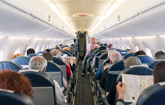NEW YORK, April 22, 2024 /PRNewswire/ -- The global commercial airlines market size is estimated to grow by USD 260 bn from 2023 to 2027, according to Technavio. The market is estimated to grow at a CAGR of 6.31% during the forecast period. APAC held the largest share of the global market in 2022, and the market in the region is estimated to witness an incremental growth of 52%.
For more insights on the forecast market size and historic data (2017 - 2021) - Buy Now
Major Players in the Market
Numerous companies are capitalizing on this growing trend by implementing strategic measures such as alliances, partnerships, mergers, and acquisitions. Among the notable players in the cheese based snacks market are:
Air China Ltd., Air France KLM SA, Air Transport Services Group Inc., American Airlines Group Inc., Ana Holdings Inc., China Eastern Airlines Co. Ltd., China Southern Airlines Co. Ltd., Copa Holdings SA, Delta Air Lines Inc., Deutsche Lufthansa AG, easyJet plc, Green Africa Airways Ltd., Hahn Air Lines GmbH, InterGlobe Aviation Ltd., International Consolidated Airlines Group SA, Japan Airlines Co. Ltd., John Swire and Sons Ltd., Qantas Airways Ltd., Southwest Airlines Co., United Airlines Inc.
Analyst Review
In the Commercial Airlines Market, modern and fuel-efficient Narrowbody Aircraft are the preferred Sub-Aircraft Type for many Passenger Aircraft operators. These aircraft boast advanced Body Types, integrating innovative technologies such as new Engine programs and improved Fuselage designs. Product offerings include the ATR series, renowned for their efficiency in Cargo transportation. Wings, Cockpit, Engine, Propeller, Tail assembly, and Landing gear are all crucial components, ensuring safe and reliable operations. Commercial Helicopters and Gliders also play a role in the market, catering to specific transportation needs. Overall, the Commercial Airlines Market continues to evolve, driven by advancements in New aircraft technologies.
Key Market Drivers
The commercial airlines market encompasses freighters and civilian aircraft, with a focus on cargo transportation. Freighters feature large fuselages, expansive wings, and robust landing gear, accommodating bulk goods. Commercial aircraft, including narrow-body and wide-body models, prioritize passenger comfort and efficiency. Cockpits house advanced technology, while engines, whether propeller or jet, power the aircraft. Tail assemblies ensure stability in flight. The private sector drives growth in commercial helicopters, gliders, and drones for various applications. Aircraft turbines and engines, such as rocket engines, turboshafts, and fuel-efficient engines, power these aircraft. Geopolitical stability and environmental regulations influence air travel demand and airline profitability. Sustainable aviation initiatives, urban air mobility, and technology integration are shaping the future of the industry. Legal frameworks govern commercial drone use, while machine learning and artificial intelligence enhance aircraft safety and operational efficiency. Parts manufacturing and maintenance are essential components of the market, with ongoing research in advanced materials and special waivers for innovative technologies.
Challenges and Opportunities
The Commercial Airline Market is experiencing heightened operating expenses (OPEX) due to rising fuel prices and increasing labor costs. Fuel prices are influenced by geopolitical events, such as US sanctions on Iran oil exports and OPEC production cuts. Labor costs, on the other hand, are fixed costs but are currently rising significantly. These factors are putting pressure on unit costs and negatively impacting profit margins for airlines. Despite these challenges, the air transport industry continues to evolve, with modern, fuel-efficient narrowbody aircraft being a key focus for product offerings. UNWTO data indicates a growing number of cross-border travelers, driving air passenger traffic. Emerging countries are expanding their fleets, with infrastructure growth and increasing per capita income fueling demand. Fleet management remains crucial for airlines, with aircraft orders influenced by economic conditions. New aircraft technologies, engine programs, and sub-aircraft types like SpaceJet, Turbofan, and Turboprop, are shaping the industry. Cargo transportation via freighters, commercial helicopters, commercial gliders, and drones is also growing. The airline industry's future lies in balancing fuel efficiency, fleet expansion plans, and catering to the needs of the business and leisure sectors. Aircraft turbines, fuselages, wings, cockpits, engines, propellers, tail assemblies, and landing gear are all essential components in this dynamic landscape.
In the dynamic commercial aviation market, smart airports play a pivotal role in enhancing efficiency and profitability for stakeholders. Integrating aircraft engines, including turboshaft and jet, through a digital grid enables real-time information sharing among the private sector, airlines, and passengers. This approach benefits from geopolitical stability and environmental regulations, driving the adoption of sustainable aviation technologies like fuel-efficient engines and advanced materials. Urban air mobility and commercial drone use, under legal frameworks, offer new opportunities for connectivity and fleet management. Machine learning and artificial intelligence optimize product offerings, while aircraft safety remains paramount. Wide-body and narrow-body aircraft, including modern sub-aircraft types, adapt to air travel demand and operating costs. The UNWTO, GDP, and cross-border travelers fuel air passenger traffic in emerging countries. Technology integration and fuel-efficient engines are key to maintaining profitability amidst volatile economic conditions.
To understand more about this market- Download a FREE Sample Report in minutes!
Market Overview
The Commercial Airlines Market encompasses various aspects of the aviation industry, including aircraft manufacturing, fuel efficiency, and customer services. Passengers seek affordable and comfortable travel experiences, with Aircraft being a crucial factor. Aircraft manufacturers like Boeing and Airbus produce modern, fuel-efficient planes such as the 787 Dreamliner and the A350 XWB. The Typical Body Type for commercial airlines is narrow-body, with a seating capacity of around 150-240 passengers. The Subtype of commercial airlines can be categorized as narrow-body, wide-body, or very large aircraft. The Production Costs for these aircraft are substantial, but the demand for air travel continues to grow. The Offering of onboard services, such as in-flight entertainment and connectivity, is essential for airlines to attract and retain customers. The Fleet of commercial airlines is subject to regulations from domestic and international authorities, ensuring safety and security for passengers. The Future of commercial aviation lies in the development of sustainable fuels and advanced technologies, such as electric or hydrogen-powered aircraft.
About Technavio
Technavio is a leading global technology research and advisory company. Their research and analysis focuses on emerging market trends and provides actionable insights to help businesses identify market opportunities and develop effective strategies to optimize their market positions.
With over 500 specialized analysts, Technavio's report library consists of more than 17,000 reports and counting, covering 800 technologies, spanning across 50 countries. Their client base consists of enterprises of all sizes, including more than 100 Fortune 500 companies. This growing client base relies on Technavio's comprehensive coverage, extensive research, and actionable market insights to identify opportunities in existing and potential markets and assess their competitive positions within changing market scenarios.
Contacts
Technavio Research
Jesse Maida
Media & Marketing Executive
US: +1 844 364 1100
UK: +44 203 893 3200
Email: [email protected]
Website: www.technavio.com/
SOURCE Technavio
WANT YOUR COMPANY'S NEWS FEATURED ON PRNEWSWIRE.COM?
Newsrooms &
Influencers
Digital Media
Outlets
Journalists
Opted In






Share this article